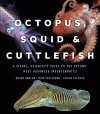Field / Identification Guide
By: Roger T Hanlon(Author), Mike Vecchione(Author), Louise Allcock(Author)
224 pages, 150+ colour photos, b/w illustrations, colour distribution maps
A visual treat, this is a fantastic popular introduction to cephalopods.
![Octopus, Squid & Cuttlefish Octopus, Squid & Cuttlefish]()
Click to have a closer look
About this book
Contents
Customer reviews
Biography
Related titles
Recommended titles
About this book
A treasure trove of scientific fact and visual explanation offers a comprehensive review of these fascinating and mysterious marine invertebrates. There are over 700 species of cephalopod, and their existence proofs that intelligence develops in very different ways – it is not by accident that these creatures are favourite models for science fiction and fantasy. While whale brains look somewhat similar to ours, cephalopods carry a large percentage of their brains in their arms. They are capable of learning, and of retaining information. They have eyes and other senses rivalling those of humans, they change texture and body shape, and they change colour faster than a chameleon. From the lone, inky hunting of the octopus, to the social squid, and the unusually large brained cuttlefish, Octopus, Squid, & Cuttlefish reveals the evolution, anatomy, life history, behaviours, and relationships of these spellbinding creatures.
Contents
Introduction
Chapter One: Cephalopod Anatomy
Advanced Invertebrates
Inside the Cephalopod
Emperor Nautilus
Giant Pacific Octopod
Pharaoh Cuttlefish 46
Bigfin Squid
Japanese Flying Squid
Rough Glass Squid
Chapter Two: Phylogeny & Evolution
500 Million Years of Evolution
Nautilus—Living Fossil?
Evolution of Coleoids
The Buoyancy Conundrum
Octopodiformes
Decapodiformes
Cephalopods & Fishes: Convergent Evolution
On Dwarfs & Giants
Evolution & Climate Change
Fuzzy Nautilus
Common Blanket Octopus
Vampire
Two-toned Pygmy Idiosepiid
Caribbean Reef Octopus
Flamboyant Cuttlefish
Analogous Bobtail Squid
Opalescent Inshore Squid
Eye-flash Squid
Chapter Three: Peculiar Lifestyles
Reproduction
Development
Age & Growth
Locomotion
Cephalopods of Various Biomes
Migration
Humboldt Squid
Greater Argonaut
Striped Pyjama Squid
Thumbstall Squid
Agassiz’s Whiplash Squid
Pacific Warty Octopod
Balloon Dumbo Octopod
Chapter Four: Behavior, Cognition & Intelligence
Decision Making
Rapid Adaptive Coloration
Nature’s Best Camouflage
When Camouflage Fails
Super Fights for Mates
Sneaky Males & Sneakier Females
Evaluating Intelligence in Such Bizarre Animals
Common Octopus
Day Octopus
Mimic Octopus
Common European Cuttlefish
Giant Australian Cuttlefish
Broadclub Cuttlefish
Long-finned Inshore Squid
Caribbean Reef Squid
Chapter Five: Cephalopods & Humans
World Fisheries & Human Consumption
A Rich History of Biomedical & Biological Advances
Bio-inspired Materials Science & Engineering
Horned Octopod
Lesser Two-spotted Octopod
Southern Blue-ringed Octopus
Hawaiian Bobtail
Cape Hope Squid
Veined Squid
Jewel Squid
Sparkling Enope Squid
Glossary
Resources
Notes on Contributors
Index
Acknowledgments
Customer Reviews
Biography
Dr Roger Hanlon PhD is the Senior Scientist at the Marine Biological Laboratory in Woods Hole Massachussetts and Professor of Ecology and Evolutionary Biology at Brown University. As co-author of Cephalopod Behaviour (CUP, 2nd ed. 2016) and 215 peer-reviewed papers on cephalopods, he is a world-renowned expert on his subject.
Dr Mike Vecchione is Director of the NOAA Fisheries National Systematics Laboratory and adjunct faculty member at the Virginia Institute of Marine Science. He is expert on evolutionary relationships among living squid, cuttlefish, octopods, and their relatives.
Dr Louise Allcock is a lecturer in Zoology at NUI Galway and President of the Cephalopod International Advisory Council, as well as co-ordinator of the IUCN red data list for cephalopoda.
Field / Identification Guide
By: Roger T Hanlon(Author), Mike Vecchione(Author), Louise Allcock(Author)
224 pages, 150+ colour photos, b/w illustrations, colour distribution maps
A visual treat, this is a fantastic popular introduction to cephalopods.
"Cephalopods are often misunderstood creatures. Three biologists set the record straight on the behaviors and evolution of these invertebrates of the sea."
– Science News







![Sekaiichi Wakari Yasui Ikatotako No Zukan [Octopus, Squid & Cuttlefish A Visual, Scientific Guide to the Oceans' Most Advanced Invertebrates] Sekaiichi Wakari Yasui Ikatotako No Zukan [Octopus, Squid & Cuttlefish A Visual, Scientific Guide to the Oceans' Most Advanced Invertebrates]](http://mediacdn.nhbs.com/jackets/jackets_resizer/25/253318.jpg)















![Ika Tako Wa Umi No Majutsu-Shidearu! [Squid and Octopus are Magicians of the Sea!]](http://mediacdn.nhbs.com/jackets/jackets_resizer_medium/26/264286.jpg?height=150&width=106)











